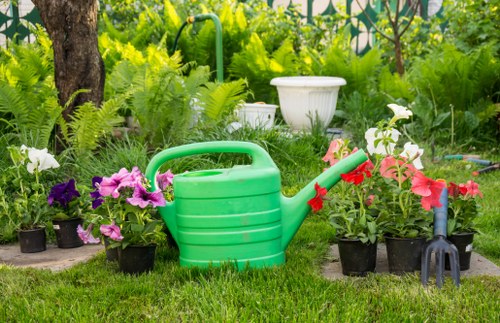Landscape Gardening in Regents Park: Transforming Urban Spaces

Regents Park, nestled in the heart of London, is renowned for its breathtaking landscapes and meticulously maintained gardens. **Landscape gardening** in Regents Park is not just about aesthetic appeal; it plays a crucial role in enhancing the urban environment, providing a serene escape from the bustling city life.
The art of landscape gardening involves the thoughtful arrangement of plants, trees, and other elements to create a harmonious and functional outdoor space. In Regents Park, this practice is elevated to an art form, combining traditional techniques with modern innovations to produce stunning vistas that attract both locals and tourists alike.
One of the key aspects of landscape gardening in Regents Park is the emphasis on sustainability. Gardeners here prioritize eco-friendly practices, ensuring that the gardens not only look beautiful but also contribute positively to the environment.

The History of Regents Park Gardens
Regents Park has a rich history that dates back to the early 19th century. Originally designed by John Nash, a prominent British architect, the park was part of the grand plan to create a series of green spaces that would adorn the outskirts of London.
Over the years, the landscape gardening in Regents Park has evolved significantly. From the initial Georgian-style gardens to the present-day eclectic mix of flora, the park has undergone numerous transformations, each adding to its unique charm.
Today, Regents Park is home to several notable gardens, including the Queen Mary's Rose Garden, the Privy Garden, and the Spectacle Lake area, each showcasing different styles and techniques in landscape gardening.

Key Elements of Landscape Gardening in Regents Park
Successful landscape gardening in Regents Park hinges on several key elements:
- Plant Selection: Choosing the right plants that thrive in the local climate and complement each other in color and texture.
- Water Features: Incorporating ponds, fountains, and streams to add tranquility and aesthetic value.
- Pathways and Walkways: Designing accessible and visually appealing paths that guide visitors through the gardens.
- Seating Areas: Creating spaces where visitors can relax and enjoy the scenery.
Each element is carefully planned and executed to ensure a cohesive and inviting landscape.

Seasonal Gardening in Regents Park
One of the joys of Regents Park is its seasonal transformations. **Landscape gardening** here adapts to the changing seasons, ensuring that the park remains vibrant and lively all year round.
Spring: The park bursts into life with a plethora of blooming flowers, including tulips, daffodils, and cherry blossoms. This season is perfect for planting new species and rejuvenating existing beds.
Summer: Lush greenery and colorful blooms dominate the landscape. Gardeners focus on maintaining the health of plants and ensuring adequate watering during the hotter months.

Autumn and Winter in Regents Park
As autumn arrives, the foliage in Regents Park transforms into a tapestry of red, orange, and yellow hues. This season is ideal for planting trees that provide autumn color and for preparing the gardens for the colder months.
Winter presents its own challenges and opportunities. Deciduous plants shed their leaves, but evergreen species and winter-blooming flowers add structure and color to the landscape. Gardeners use this time to plan for the next planting season and to implement any necessary maintenance.
The ability to adapt to each season is a testament to the skill and dedication of the landscape gardeners in Regents Park.
Eco-Friendly Practices in Regents Park Landscaping
In an era where environmental sustainability is paramount, Regents Park stands out for its commitment to eco-friendly landscaping practices. The landscape gardeners here employ various strategies to minimize their environmental footprint while maintaining the beauty of the gardens.
- Rainwater Harvesting: Collecting and utilizing rainwater for irrigation to reduce dependency on municipal water supplies.
- Composting: Recycling organic waste to create nutrient-rich compost, promoting soil health and reducing landfill waste.
- Native Planting: Using native species that are well-adapted to the local climate, requiring less water and maintenance.
- Pest Management: Implementing natural pest control methods to avoid chemical usage.
These practices not only contribute to the health of the gardens but also serve as educational examples for visitors on the importance of sustainable gardening.
Community Engagement and Education
Regents Park isn't just a beautiful space; it's also a hub for community engagement and education. The landscape gardening projects often involve local communities, offering workshops, guided tours, and volunteer opportunities.
Educational programs focus on teaching sustainable gardening practices, the importance of biodiversity, and the role of green spaces in urban settings. These initiatives foster a sense of ownership and appreciation among residents, ensuring the continued care and preservation of the park.
By involving the community, Regents Park's landscape gardening transcends aesthetics, becoming a cornerstone for environmental stewardship and social interaction.
Challenges in Urban Landscape Gardening
While the results are stunning, landscape gardening in an urban setting like Regents Park comes with its own set of challenges:
- Space Limitations: Maximizing beauty and functionality within confined spaces requires innovative design solutions.
- Pollution: Urban pollution can impact plant health, necessitating the selection of resilient species and protective measures.
- Maintenance: High foot traffic and diverse visitor activities demand diligent maintenance to preserve the gardens.
- Budget Constraints: Allocating sufficient resources for large-scale gardening projects can be challenging.
Despite these obstacles, the dedicated landscape gardeners of Regents Park consistently overcome them, ensuring the park remains a green oasis in the city.
Innovative Design Techniques
To address the challenges of urban gardening, Regents Park landscape gardeners employ a range of innovative design techniques:
- Vertical Gardening: Utilizing vertical spaces to grow plants, maximizing limited ground area.
- Modular Planting: Creating flexible planting modules that can be easily rearranged or replaced.
- Sustainable Materials: Incorporating recycled and sustainable materials in garden structures and pathways.
- Technology Integration: Using smart irrigation systems and other technologies to enhance efficiency and reduce resource usage.
These techniques not only enhance the beauty of the gardens but also contribute to their sustainability and resilience.
The Role of Art in Regents Park Landscaping
Art and landscape gardening often intertwine in Regents Park, creating a dynamic and engaging environment. Sculptures, water features, and artistic installations are strategically placed throughout the gardens, adding layers of interest and inviting visitors to explore and interact with the space.
These artistic elements serve as focal points, enhancing the visual appeal and providing unique experiences for visitors. They also reflect the cultural heritage and contemporary creativity of the community, making Regents Park not just a garden but a living gallery.
The collaboration between artists and landscape gardeners results in a symbiotic relationship where both art and nature flourish.
Future Prospects of Landscape Gardening in Regents Park
The future of landscape gardening in Regents Park looks promising, with plans for further enhancements and expansions. Upcoming projects focus on increasing biodiversity, incorporating more sustainable practices, and enhancing visitor facilities.
Innovations such as green roofs, urban beekeeping areas, and interactive gardens are being explored to keep the park at the forefront of modern landscaping trends.
As urban landscapes continue to evolve, Regents Park remains committed to setting standards in landscape gardening, ensuring that it remains a cherished green space for generations to come.
How You Can Get Involved
If you’re inspired by the landscape gardening efforts in Regents Park, there are several ways you can get involved:
- **Volunteer:** Join local gardening groups or participate in park clean-up events.
- **Attend Workshops:** Learn about sustainable gardening practices and contribute to community projects.
- **Donate:** Support the maintenance and expansion of the park through financial contributions.
- **Advocate:** Promote the importance of green spaces in urban environments and encourage others to take part.
By getting involved, you not only help preserve the beauty of Regents Park but also contribute to a healthier and more sustainable urban ecosystem.
Contact us today to learn more about how you can participate in enhancing Regents Park’s landscape gardening initiatives.
Conclusion
**Landscape gardening in Regents Park** is a testament to the harmonious blend of nature, art, and sustainability in an urban setting. Through dedicated efforts, innovative practices, and community involvement, Regents Park continues to thrive as a green sanctuary, offering beauty and tranquility to all who visit.
Whether you’re a gardening enthusiast, a nature lover, or simply seeking a peaceful retreat, Regents Park’s gardens provide a perfect escape. Embrace the serenity and contribute to the ongoing legacy of this magnificent urban landscape.
Book your service now and be a part of Regents Park’s vibrant gardening community.

